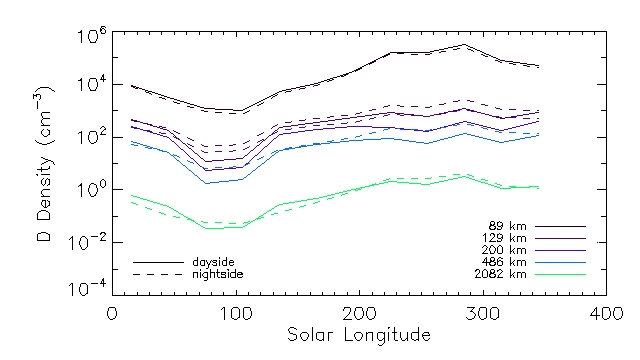Simulation of the atomic deuterium density and escape at Mars and comparison with MAVEN/IUVS observations
- 1Paris, France (chaufray@latmos.ipsl.fr)
- 2IAA, CSIS, Granada, Spain
- 3LMD, Paris, France
- 4Boston University, Boston, USA
The D/H ratio is a key parameter to understand the atmospheric evolution of a planet. On Mars a D/H ~ 5 times larger than the ratio on Earth is measured. This large ratio can be explained by a preferential escape of the hydrogen compared to the deuterium due to its lower mass. However, while the thermal escape (Jeans escape) is strongly mass dependent other non-thermal processes are less mass dependent and would impact the time needed to fractionate the water from the terrestrial value to the current value.
After the first detections of the deuterium Lyman-α emission from Earth (Bertaux et al. 1992, Krasnopolsky et al. 1998), the mission MAVEN performed the first systematic observations of the atomic deuterium Lyman-α emission around Mars showing a brightness of several hundreds of Rayleigh near Mars winter solstice (Clarke et al. 2017, Mayyasi et al. 2017), much larger than the Earth detections done near aphelion (~ 20 – 50 Rayleighs). This seasonal variation of the deuterium Lyman-α brightness is consistent with the variations of the hydrogen Lyman-α brightness observed from Mars Express (Chaffin et al. 2014, Chaufray et al. 2021), HST (Clarke et al. 2014), and MAVEN/IUVS (Clarke et al. 2017, Chaffin et al. 2018) and should result from the processes transporting the water vapor from the lower atmosphere to the upper atmosphere (Vals et al. 2022).
In this work we will present preliminary simulations of the 3D deuterium abundance in the Martian upper atmosphere (Fig. 1) using a 3D time dependent global circulation model, including the chemical reactions between HD and HDO with the ions in the upper atmosphere, its extension in the exosphere, and a comparison of the simulated D Lyman-α brightness with the brightness measured by MAVEN/IUVS (Mayyasi et al. 2017) for the Martian year 33.

Fig. 1 Simulated average dayside and nightside D density at different altitudes in the thermosphere and exosphere along one Martian year.
We will also present first results of the simulated non-thermal escape of H and D produced by collisions between hot oxygen with H, D, H2 and HD as well as the escape of planetary H+ and D+ driven by the solar wind interaction. We will compare the D and H thermal escape rate with the non-thermal escape rates.
References:
Bertaux et al. (1992), in ESOC conference and workshop proceedings, 44, 459.
Chaffin, M. et al. (2014), Geophys. Res. Lett., 41, 314-320
Chaffin, M. et al. (2018), J. Geophys. Res., 123, 2192-2210
Chaufray et al., (2021), Icarus, 353,113498
Clarke et al. (2014), Geophys. Res. Lett., 41, 8013-8020
Clarke et al. (2017), J. Geophys. Res., 122, 2336-2344
Krasnopolsky et al., (1998), Science, 280, 1576
Mayyasi et al., (2017), J. Geophys. Res., 122, 10811-10823
Vals et al. (2022), J. Geophys. Res., under revisions
How to cite: Chaufray, J.-Y., Gonzalez-Galindo, F., Vals, M., Rossi, L., Montmessin, F., Lefevre, F., Leblanc, F., Modolo, R., Forget, F., Millour, E., Gilli, G., Lopez-Valverde, M., and Mayyasi, M.: Simulation of the atomic deuterium density and escape at Mars and comparison with MAVEN/IUVS observations, Europlanet Science Congress 2022, Granada, Spain, 18–23 Sep 2022, EPSC2022-568, https://doi.org/10.5194/epsc2022-568, 2022.

